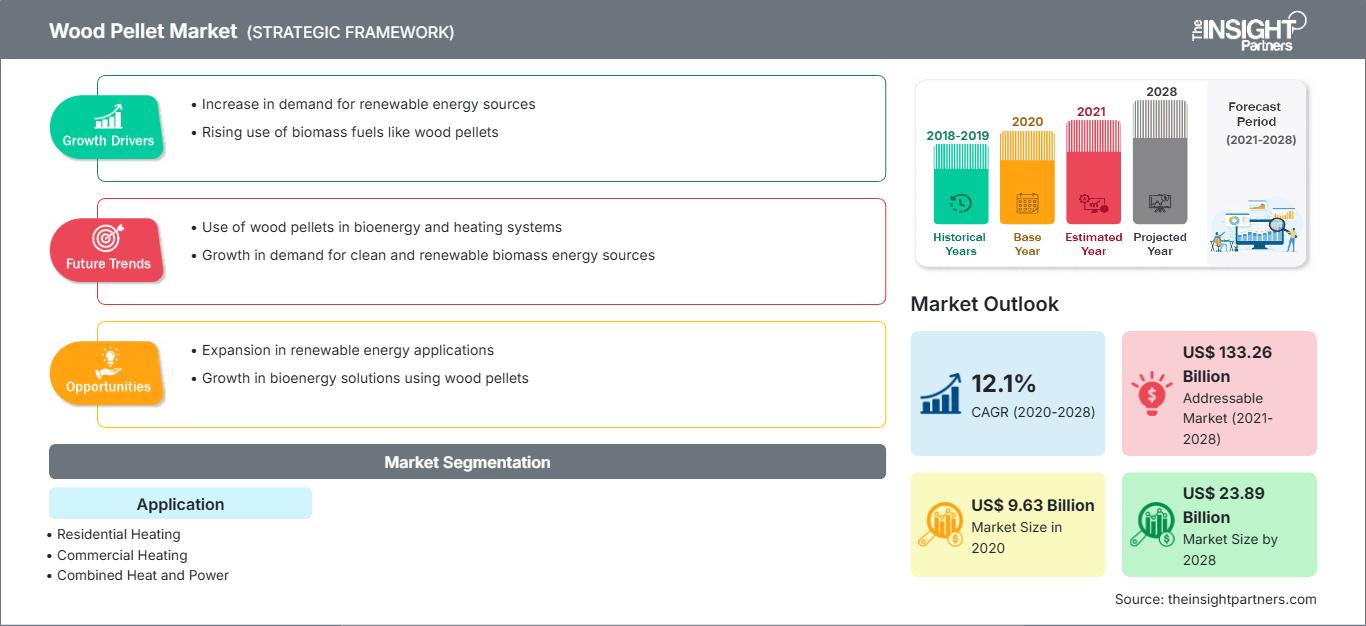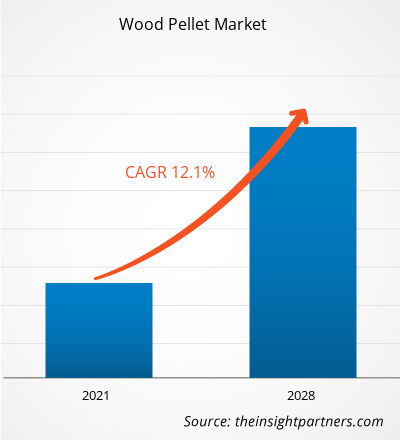2020 年,木质颗粒市场价值为 96.3099 亿美元,预计到 2028 年将达到 238.9277 亿美元;预计 2021 年至 2028 年的复合年增长率为 12.1%。
木质颗粒使用精细研磨的木皮制成;它们主要用作燃料。它们广泛用于住宅,以便在小型炉灶中高效燃烧。木质颗粒由多种木材废料制成,被认为是一种可再生能源。目前,除了住宅供暖外,全球范围内木质颗粒用于发电的使用也在增加。它们在全球范围内被广泛用作燃料,预计未来几年对木质颗粒的需求将增加。欧洲是用于发电的木质颗粒消费的主要地区。此外,北美是木屑颗粒的重要出口地,预计未来几年将增加木屑颗粒的生产设施。
2020 年,欧洲在全球市场中占有最大份额。提交给美国农业部对外农业服务局全球农业信息网络的年度报告显示,欧洲木屑颗粒市场相对未受 COVID-19 疫情的影响。报告显示,该地区 2018 年消费了约 2900 万公吨木屑颗粒,是全球最大的颗粒市场。木屑颗粒用于住宅供暖和工业供热发电。报告进一步指出,该地区目前约占全球颗粒产量的 30%。然而,该地区是全球木屑颗粒消费的主要地区。意大利、德国等国家被视为住宅供暖应用中木屑颗粒消费的主要增长市场。英国是木屑颗粒的主要消费国之一,其次是意大利和丹麦。
受新冠疫情影响,全球木屑颗粒市场面临诸多挑战。持续的新冠疫情彻底改变了化学和材料行业的现状,并对木屑颗粒市场的增长产生了负面影响。防控措施的实施加剧了形势,影响了多个工业部门的增长。由于国内和国际边界的突然关闭,运营效率突然失调,价值链中断,市场受到了冲击。无限期封锁和临时隔离导致从供应商采购原材料中断,制造基地暂时关闭,这些都影响了疫情期间的市场增长。根据Woodcote Media Ltd于2020年7月30日发布的一则新闻,木质颗粒认证计划ENplus开展的一项调查显示,75%的认证生产商受到了新冠疫情的负面影响。这些公司正计划调整最终用户的木质颗粒价格。然而,同一报告也指出,约5%的受访者认为最终用户对木质颗粒的需求略有增加。同样,木材供应链也受到了疫情的影响,导致原材料供应和价格中断。
自定义此报告以满足您的要求
您将免费获得任何报告的定制,包括本报告的部分内容,或国家级分析、Excel 数据包,以及为初创企业和大学提供超值优惠和折扣
木质颗粒市场: 战略洞察

- 获取本报告的主要市场趋势。这个免费样本将包括数据分析,从市场趋势到估计和预测。
市场洞察:可再生能源使用意识不断增强
您将免费获得任何报告的定制,包括本报告的部分内容,或国家级分析、Excel 数据包,以及为初创企业和大学提供超值优惠和折扣
木质颗粒市场: 战略洞察

- 获取本报告的主要市场趋势。这个免费样本将包括数据分析,从市场趋势到估计和预测。
可再生能源在满足城乡未来能源需求方面发挥着至关重要的作用。资源的稀缺,以及人们对化石产品和工艺对环境负面影响的认识不断提高,导致对木质颗粒等可再生能源的依赖性激增。对可持续能源发展的日益增长的需求是木质颗粒需求增长的另一个因素。可再生能源资源和技术被认为是环境友好的替代品,因为与其他形式的能源相比,它们通常对环境的影响有限或没有影响。此外,这些资源易于获取,不会枯竭。
木质颗粒被归类为可再生能源,因为它们来源于树木,是一种生物质。木质颗粒由干燥和压缩的木纤维组成,这些木纤维由锯木厂残渣、伐木残渣(例如森林残渣堆)和整根原木制成。根据美国能源信息署的数据,生物质被归类为可以有效用作能源的有机材料。多种生物质,例如木质颗粒,都是碳中性的,燃烧生物质后不会留下净零碳足迹。
类型洞察
根据应用,全球木质颗粒市场细分为住宅供暖、商业供暖、热电联产 (CHP) 和发电。住宅供暖领域在 2020 年引领了全球木质颗粒市场。木质燃料系统在世界各地广泛用于住宅供暖,最近木质颗粒已经取代了传统的木柴。用于住宅供暖的木质颗粒锅炉具有低排放、高效率和自动化运行的特点。木质颗粒用于颗粒炉中的住宅供暖。它们还用于颗粒锅炉,在服务业、发电业和制造业中产生热量、蒸汽和电力。它用于制造业和能源行业的发电和供热,这推动了木质颗粒市场的发展。由于木质颗粒的成本长期以来一直低于其他燃料,因此它成为一种更经济的选择,解决了住宅部门的主要顾虑。作为一种可再生能源,木质颗粒已获得多个国家政府的激励和补贴。近年来,许多国家出台或更新了与木质颗粒供暖应用相关的政策和计划。
木质颗粒市场的主要参与者包括 Pacific BioEnergy、Premium Pellet Ltd.、Pinnacle Renewable Energy、Enviva、ANDRITZ、Wood & Sons、Graanul Invest、New England Wood Pellet、TANAC 和 Energex Pellet Fuel, Inc.
报告重点
- 全球木质颗粒市场不断发展的行业趋势,帮助参与者制定有效的长期战略
- 发达市场和发展中市场采用的业务增长战略
- 2019 年至 2028 年全球木质颗粒市场的定量分析
- 各行业对木质颗粒市场需求的估计
- PEST 分析,说明行业买家和供应商预测市场增长的有效性
- 了解竞争激烈的市场形势和木质颗粒需求的最新发展
- 市场趋势和前景,以及推动和抑制木质颗粒市场增长的因素
- 通过了解支撑全球木质颗粒市场增长商业利益的策略来进行决策过程
- 不同节点的木质颗粒市场规模市场
- 全球木质颗粒市场的详细概述和细分,以及其行业动态
- 各地区木质颗粒市场规模及良好的增长机会
木质颗粒市场区域洞察
The Insight Partners 的分析师已详尽阐述了预测期内影响木屑颗粒市场的区域趋势和因素。本节还讨论了北美、欧洲、亚太地区、中东和非洲以及南美和中美洲的木屑颗粒市场细分和地域分布。
木质颗粒市场报告范围
| 报告属性 | 细节 |
|---|---|
| 市场规模 2020 | US$ 9.63 Billion |
| 市场规模 2028 | US$ 23.89 Billion |
| 全球复合年增长率 (2020 - 2028) | 12.1% |
| 历史数据 | 2018-2019 |
| 预测期 | 2021-2028 |
| 涵盖的领域 |
By 应用
|
| 覆盖地区和国家 | 北美
|
| 市场领导者和主要公司简介 |
|
木质颗粒市场参与者密度:了解其对业务动态的影响
木质颗粒市场正在快速增长,这得益于终端用户需求的不断增长,而这些需求的驱动因素包括消费者偏好的不断变化、技术进步以及对产品优势的认知度不断提高。随着需求的增长,企业正在扩大产品线,不断创新以满足消费者需求,并抓住新兴趋势,从而进一步推动市场增长。

- 获取 木质颗粒市场 主要参与者概述
- 按应用,全球木质颗粒市场细分为住宅供暖、商业供暖、热电联产 (CHP) 和发电。
公司简介
- Pacific BioEnergy
- Premium Pellet Ltd.
- Pinnacle Renewable Energy
- Enviva
- ANDRITZ
- Wood & Sons
- Graanul Invest
- New England Wood Pelletv5/8520
- TANAC
- Energex Pellet Fuel, Inc.
- 历史分析(2 年)、基准年、预测(7 年)及复合年增长率
- PEST和SWOT分析
- 市场规模、价值/数量 - 全球、区域、国家
- 行业和竞争格局
- Excel 数据集
近期报告
相关报告
客户评价
购买理由
- 明智的决策
- 了解市场动态
- 竞争分析
- 客户洞察
- 市场预测
- 风险规避
- 战略规划
- 投资论证
- 识别新兴市场
- 优化营销策略
- 提升运营效率
- 顺应监管趋势




















 获取免费样品 - 木质颗粒市场
获取免费样品 - 木质颗粒市场